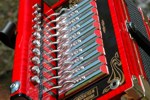
For those inquiring minds
This is What actually happened on the Transocean rig explosion.

Based on the interviews, Bea believes that the workers set and then tested a cement seal at the bottom of the well. Then they reduced the pressure in the drill column and attempted to set a second seal below the sea floor. A chemical reaction caused by the setting cement created heat and a gas bubble which destroyed the seal.
Deep beneath the seafloor, methane is in a slushy, crystalline form. Deep sea oil drillers often encounter pockets of methane crystals as they dig into the earth.
As the bubble rose up the drill column from the high-pressure environs of the deep to the less pressurized shallows, it intensified and grew, breaking through various safety barriers, Bea said.
"A small bubble becomes a really big bubble," Bea said. "So the expanding bubble becomes like a cannon shooting the gas into your face."
Up on the rig, the first thing workers noticed was the sea water in the drill column suddenly shooting back at them, rocketing 240 feet in the air, he said. Then, gas surfaced. Then oil.
"What we had learned when I worked as a drill rig laborer was swoosh, boom, run," Bea said. "The swoosh is the gas, boom is the explosion and run is what you better be doing."
The gas flooded into an adjoining room with exposed ignition sources, he said.
"That's where the first explosion happened," said Bea, who worked for Shell Oil in the 1960s during the last big northern Gulf of Mexico oil well blowout. "The mud room was next to the quarters where the party was. Then there was a series of explosions that subsequently ignited the oil that was coming from below."
The first attempt at setting the containment pod over the gushing well has been unsuccessful.
They are going to try again, this is the first time that this containment pod has been used at these depths.
Just thought you guys may want to know.
9 Rig/Deck hands and 2 engineers were killed, god be with them and their families!

